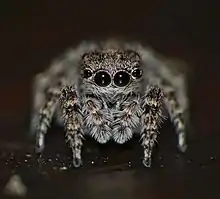Langelurillus horrifer
Langelurillus horrifer is a species of jumping spider in the genus Langelurillus that lives in Guinea. The female was first described in 2002 by Christine Rollard and Wanda Wesołowska. The male has not been identified. It is a small brown spider with a carapace that measures 2.1 mm (0.083 in) in length and an abdomen that is typically 2.7 mm (0.11 in) long. It is distinguished from similar spiders, like Langelurillus difficilis, by its complicated epigyne with its long spiralling seminal ducts.
| Langelurillus horrifer | |
|---|---|
 | |
| A spider of the Langelurillus genus | |
| Scientific classification | |
| Domain: | Eukaryota |
| Kingdom: | Animalia |
| Phylum: | Arthropoda |
| Subphylum: | Chelicerata |
| Class: | Arachnida |
| Order: | Araneae |
| Infraorder: | Araneomorphae |
| Family: | Salticidae |
| Subfamily: | Salticinae |
| Genus: | Langelurillus |
| Species: | L. horrifer |
| Binomial name | |
| Langelurillus horrifer Rollard & Wesołowska, 2002 | |
Taxonomy
Langelurillus horrifer was first described by Christine Rollard and Wanda Wesołowska in 2002.[1] It was one of over 500 species identified by the Polish arachnologist Wesołowska during her career.[2] They allocated it to the genus Langelurillus, which had been raised by Maciej Próchniewicz in 1994.[3][4][5] The genus is related to Aelurillus and Langona but the spiders are smaller and, unlike these genera and Phlegra, they lack the parallel stripes on the back of the body that is feature of the majority of these spiders.[6] In 2015, Wayne Maddison placed the genus in the subtribe Aelurillina, which also contained Aelurillus, Langona and Phlegra, in the tribe Aelurillini, within the subclade Saltafresia in the clade Salticoida.[7] In 2016, Jerzy Prószyński placed the same genera in a group named Aelurillines based on the shape of the spiders' copulatory organs.[8] The species is named after a Latin word that means terrible and relates to the complicated structure of the epigyne.[9]
Description
Langelurillus horrifer is a small spider. The female has a brown high carapace that typically has a length of 2.1 mm (0.083 in) and a width of 1.7 mm (0.067 in). IT is covered with brown and grey hairs. The chelicerae are brown and toothless. The remainder of the mouthparts are generally orange. The abdomen is rounded and more squat than the carapace, typically 2.7 mm (0.11 in) long and 2.5 mm (0.098 in) wide. It is brownish-beige on top and lighter underneath. The spinnerets are yellow and the legs are light brown, with brown hairs. The spider has an oval epigyne, raised in the middle, with two large depressions to the rear. The seminal ducts are long, spiralling into eight loops, and lead to receptacles that have two chambers.[9] The male has not been described.[1]
The species has similarities to others in the genus, particularly Langelurillus difficilis and Langelurillus nigritus. It can be distinguished by its long and complicated seminal organs.[9]
Distribution
Almost all, if not all, Langelurillus spiders live in sub-Saharan Africa.[10] Langelurillus horrifer is endemic to Guinea.[11] The female holotype was collected on the road to Bakoré in the Guinea Highlands in 1956, at an altitude of 500 m (1,600 ft) above sea level.[5]
References
Citations
- World Spider Catalog (2017). "Langelurillus horrifer Rollard & Wesolowska, 2002". World Spider Catalog. 18.0. Bern: Natural History Museum. Retrieved 7 May 2017.
- Wiśniewski 2020, p. 6.
- Próchniewicz 1994, p. 27.
- Wesołowska & Russell-Smith 2000, p. 50.
- Rollard & Wesołowska 2002, p. 296.
- Próchniewicz 1994, p. 28.
- Maddison 2015, p. 279.
- Prószyński 2017, p. 95.
- Rollard & Wesołowska 2002, p. 298.
- Logunov & Azarkina 2018, p. 120.
- Azarkina 2020, p. 40.
Bibliography
- Azarkina, Galina N. (2020). "Manzuma gen. nov., a new aelurilline genus of jumping spiders (Araneae, Salticidae)". European Journal of Taxonomy. 611: 1–47. doi:10.5852/ejt.2020.611.
- Logunov, Dmitri V.; Azarkina, Galina N. (2018). "Redefinition and partial revision of the genus Stenaelurillus Simon, 1886 (Arachnida, Araneae, Salticidae)". European Journal of Taxonomy. 430: 1–126. doi:10.5852/ejt.2018.430.
- Maddison, Wayne P. (2015). "A phylogenetic classification of jumping spiders (Araneae: Salticidae)". The Journal of Arachnology. 43 (3): 231–292. doi:10.1636/arac-43-03-231-292. S2CID 85680279.
- Próchniewicz, Maciej (1994). "The jumping spiders of the Ethiopian Region. Part I. New genus Langelurillus gen. n. (Araneae, Salticidae) from Kenya". Annales Zoologici, Warszawa (45): 27–31.
- Prószyński, Jerzy (2017). "Pragmatic classification of the World's Salticidae (Araneae)". Ecologica Montenegrina. 12: 1–133. doi:10.37828/em.2017.12.1.
- Rollard, Christine; Wesołowska, Wanda (2002). "Jumping spiders (Arachnida, Araneae, Salticidae) from the Nimba Mountains in Guinea" (PDF). Zoosystema. 24 (2): 283–307. doi:10.5281/zenodo.5394616. Retrieved 5 March 2017.
- Wesołowska, Wanda; Russell-Smith, Anthony (2000). "Jumping spiders from Mkomazi Game Reserve in Tanzania (Araneae Salticidae)". Tropical Zoology. 13 (1): 11–127. doi:10.1080/03946975.2000.10531126.
- Wiśniewski, Konrad (2020). "Over 40 years with jumping spiders: on the 70th birthday of Wanda Wesołowska". Zootaxa. 4899 (1): 5–14. doi:10.11646/zootaxa.4899.1.3. PMID 33756825. S2CID 232337200.